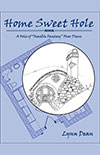Re-writing / Self-editing
As we consider story structure, we’ve compared it to laying the groundwork and frame for a house. We’ve planned (plotted), followed the blueprint (kept theme in mind), searched for incongruities in structure (those scenes, voices, or characters that just don’t fit), and revealed backstory clues. But when we get to the re-writing or self-editing stage, writing a novel is more like remodeling a tilted, old farmhouse.
My husband and I have been remodeling our old farmhouse for a number of years now. It’s slow going because whenever we rip into something, we find something hidden underneath that also needs re-doing. That’s what re-writing is like. It’s usually not until a story is finished and has been left to sit for a while that we come back and begin to notice things we didn’t see before. We take a closer look at what lies beneath the structure and realize that some wiring (plot lines) spiders off to nowhere. There are weak studs or cross beams (characters & themes) that don’t hold their weight. The plumbing (action) is rusty and clogged. We might even find rotten, bug-infested wood (useless dialogue) that needs to be torn out or replaced.
Is your work-in-progress looking like an old farm that needs a major remodel? Start by taking a look at what is precious enough and in repair to keep — the stuff that’s really supporting the old structure. But then carefully examine the underpinnings. Sometimes you don’t have to demolish a scene or a chapter, but just like the stairway and kitchen sink in our house, you have to move it to a place in which it will work better.
Exercise:
Let your finished story sit for as long as you can — a week, a month, a season if possible. (Work on something else!) When you come back to it, start peeling away the flooring and sheetrock — you know, the bare thrill of your idea — and take a good, revealing look at its underlying structure. Is it all solid, or does it need repair?
















Speak Your Mind
You must be logged in to post a comment.